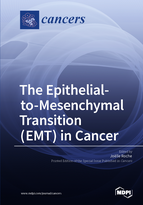The Epithelial-to-Mesenchymal Transition (EMT) in Cancer
A special issue of Cancers (ISSN 2072-6694).
Deadline for manuscript submissions: closed (31 May 2017) | Viewed by 143962
Special Issue Editor
Interests: molecular biology of lung cancer; epigenetics (histone methyltransferase and HDAC inhibitors); epithelial-to-mesenchymal transition (EMT); guidance molecules (semaphorins and neuropilins)
Special Issue Information
Dear Colleagues,
The epithelial-to-mesenchymal transition (EMT) is a highly dynamic process with multiple transitional states, by which epithelial cells can convert into a mesenchymal phenotype. This process involves loss of cellular adhesion and cellular polarity, and an improvement in migratory and invasive properties. It occurs during normal embryonic development, tissue regeneration, organ fibrosis, and wound healing. It is also involved in tumor progression with metastatic expansion, and plays a major role in resistance to cancer treatment. In cancers, EMT inducers are hypoxia, cytokines, and growth factors secreted by the tumor microenvironment, stroma crosstalk, metabolic changes, innate and adaptive immune responses, and treatment with antitumor drugs. Switch in gene expression from epithelial to mesenchymal phenotype is triggered by complex regulatory networks involving transcriptional control with SNAI1 and SNAI2, ZEB1 and ZEB2, Twist, and E12/E47 among transcriptional factors, non-coding RNAs (miRNAs and long non-coding RNAs), chromatin remodeling and epigenetic modifications, alternative splicing, post-translational regulation, protein stability and subcellular localization. Reversion of EMT, the mesenchymal-to-epithelial transition (MET), affects circulating cancer cells when they reach a desirable metastatic niche to develop secondary tumors. More knowledge and control of EMT to MET is necessary and will be beneficial for patients for cancer treatment. This current Special Issue entitled “Epithelial to Mesenchymal Transition in Cancer” will address these questions.
Prof. Dr. Joëlle Roche
Guest Editor
Manuscript Submission Information
Manuscripts should be submitted online at www.mdpi.com by registering and logging in to this website. Once you are registered, click here to go to the submission form. Manuscripts can be submitted until the deadline. All submissions that pass pre-check are peer-reviewed. Accepted papers will be published continuously in the journal (as soon as accepted) and will be listed together on the special issue website. Research articles, review articles as well as short communications are invited. For planned papers, a title and short abstract (about 100 words) can be sent to the Editorial Office for announcement on this website.
Submitted manuscripts should not have been published previously, nor be under consideration for publication elsewhere (except conference proceedings papers). All manuscripts are thoroughly refereed through a single-blind peer-review process. A guide for authors and other relevant information for submission of manuscripts is available on the Instructions for Authors page. Cancers is an international peer-reviewed open access semimonthly journal published by MDPI.
Please visit the Instructions for Authors page before submitting a manuscript. The Article Processing Charge (APC) for publication in this open access journal is 2900 CHF (Swiss Francs). Submitted papers should be well formatted and use good English. Authors may use MDPI's English editing service prior to publication or during author revisions.







